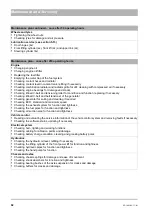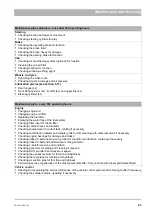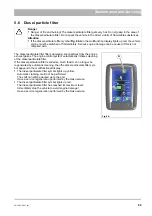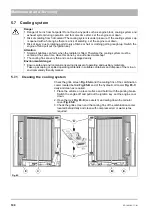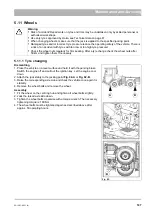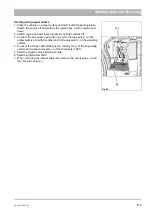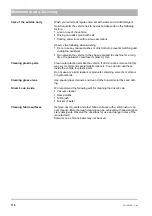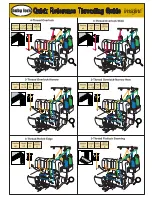
104
05-1491-00-11.fm
Maintenance and Servicing
5.9
Hydraulic system
5.9.1
Important information for using BIO OIL
Danger
•
Risk of injury from hydraulic oil! Hydraulic oil issuing under high pressure can penetrate the skin
and cause severe injuries. Therefore, even with the smallest wounds, consult a doctor since
otherwise severe infections can arise!
•
Danger of burns from hot parts! Do not touch any parts such as engine block, cooling system and
exhaust system during operation and for some time after. Let the engine cool down.
Warning
•
Do not touch any parts such as engine block, cooling system and exhaust system during
operation and for some time after – risk of burns!
•
Work on the hydraulic system of the vehicle may be done only by persons with special knowledge
and experience in hydraulics.
•
Regularly check all pipes, hoses and screw connections for leaks and external visible damage.
Immediately rectify damage and leaks. Oil squirting out can cause injuries and fires. Observe the
recommended replacement intervals for hydraulic pipes. With normal requirements 6 years, with
increased requirements on safety 2 years!
•
Do not change over hydraulic pipes! Fittings and the length and quality of the hose line must
comply with the requirements.
Environmental danger
•
Ensure safe and environment-conserving disposal of operating and auxiliary materials. Take up
escaping or spilled operating materials in suitable containers and dispose of them in an environ-
mentally friendly manner.
Attention
•
Use only the BIO hydraulic fluids approved by the Hako GmbH, see Operating materials and lubri-
cants. Use of another not recommended product must be agreed with Hako without fail. In
addition, a written guarantee declaration must be obtained from the supplier. This guarantee
applies for the case that damage to hydraulic units occurs that is demonstrably attributable to the
hydraulic fluid.
•
Use only BIO oil of the same grade for topping up and oil changing. Clear information about the
momentary oil grade used must be placed close to the filler cap! Mixing two BIO oil grades can
impair the properties of one grade. Make sure that when the BIO oil is changed, the remaining
residual volume of the original hydraulic fluid in the hydraulic system does not exceed 8 %
(manufacturer's data).
•
Do not top up with mineral oil. The mineral oil content should not exceed 2 % by weight to avoid
foaming problems and not to impair the biological degradability of the BIO oil.
•
The same oil and filter changing intervals apply for operation with BIO oils as for mineral oils, see
Operating materials and lubricants. The condensed water in the hydraulic oil tank must be drained
off before the cold season. The water content should not exceed 0.1 % by weight.
•
All information about environmental protection in this operating manual also applies when BIO oils
are used.
•
If additional hydraulic devices are attached and operated, then operate these with the same BIO
oil grades, so that mixing in the hydraulic system is avoided.
•
In subsequent oil changing from mineral to BIO oil, the hydraulic units must be scavenged
completely.
Summary of Contents for Citymaster 1600
Page 22: ...22 01 1491 00 12 fm Safety Instructions G A B D E F Fig 3 C F C E C D G A B A...
Page 26: ...26 02 1491 00 11 fm Operation Fig 5 25 23 16 18 17 19 22 21 20 24 26 27...
Page 30: ...30 02 1491 00 11 fm Operation Fig 7 62 63 61 67 55 50 51 54 53 52 58 57 59 60 65 64 66 68 56...
Page 32: ...32 02 1491 00 11 fm Operation Fig 8 75 69 78 73 72 79 80 81 82 83 74 77 70 71 76 84...
Page 85: ...04 1491 00 11 fm 85 Technical Data 4 Technical Data Fig 80 3830 1600 941 1210 975 1964...
Page 146: ...146 06 1491 00 12 fm Attachments and Options 6 1 5 Technical data Fig 144 2215 4510 1580 2250...
Page 220: ...220 06 1491 00 12 fm Attachments and Options...



